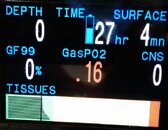This can be modeled as a saturation dive at 8000 feet (there is about 9 fsw worth of pressure increase going from 8000 feet down to the surface), followed by the dive proper. I am having some trouble getting V-Planner to generate sensible results (it seems to hang forever if you give it a 10000-minute interval in the dive profile @ 9 fsw to simulate "saturation" at the surface), but I will try to post them here shortly, once I find deco software that works... if nothing else, then just to throw in a data point into the discussion.
---------- Post added June 5th, 2014 at 05:48 PM ----------
There it is, finally... with a 10,000-minute (about a week) of a "saturation dive" to 9 fsw @ 8000 feet altitude, followed by 30 min. dive to 100+9 fsw, we get somewhere around 9-10 hours of a "surface interval" (the last planned deco stop is at 10 fsw @ 8000 feet, but if we surface at that altitude, we'll be at 9 fsw, so in reality we'll then be offgassing a little bit faster). I hope this time around I didn't end up making any silly typos. This result is at least on the same order of magnitude as DAN's recomendations (which for deco dives, as far as I can remember, was 24-48 hours). I certainly wouldn't follow this plan and bet my own life or health on its correctness, but I think it'd be very interesting to see how much more aggressive these predictions typically are compared to DAN's guidelines across a wider range of scenarios, and whether DAN's guidelines (which, AFAIK, are based on purely statistuical analysis of DCS occurrences) can be "explained" in the framework established by the popular deco models.
Decompression model: VPM - B
Surface interval = 5 day 0 hr 0 min.
Elevation = 8,000ft (s)
Conservatism = + 3
Dec to 9ft (0) Air 50ft/min descent.
Level 9ft 9999:39 (10000) Air 0.27 ppO2, 9ft ead
Dec to 109ft (10002) Air 50ft/min descent.
Level 109ft 28:00 (10030) Air 0.90 ppO2, 109ft ead
Asc to 70ft (10031) Air -30ft/min ascent.
Stop at 70ft 0:42 (10032) Air 0.65 ppO2, 70ft ead
Stop at 60ft 2:00 (10034) Air 0.59 ppO2, 60ft ead
Stop at 50ft 5:00 (10039) Air 0.53 ppO2, 50ft ead
Stop at 40ft 7:00 (10046) Air 0.46 ppO2, 40ft ead
Stop at 30ft 12:00 (10058) Air 0.40 ppO2, 30ft ead
Stop at 20ft 20:00 (10078) Air 0.34 ppO2, 20ft ead
Stop at 10ft 590:00 (10668) Air 0.27 ppO2, 10ft ead
Surface (10668) Air -30ft/min ascent.





